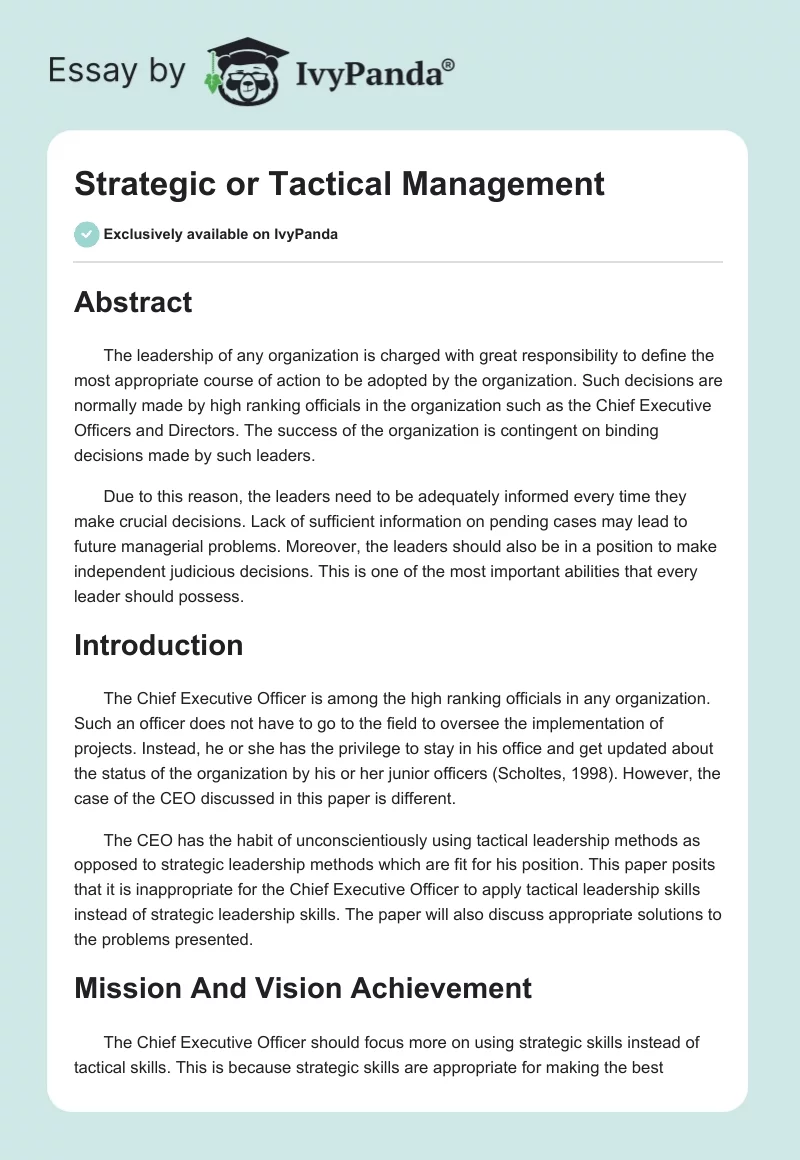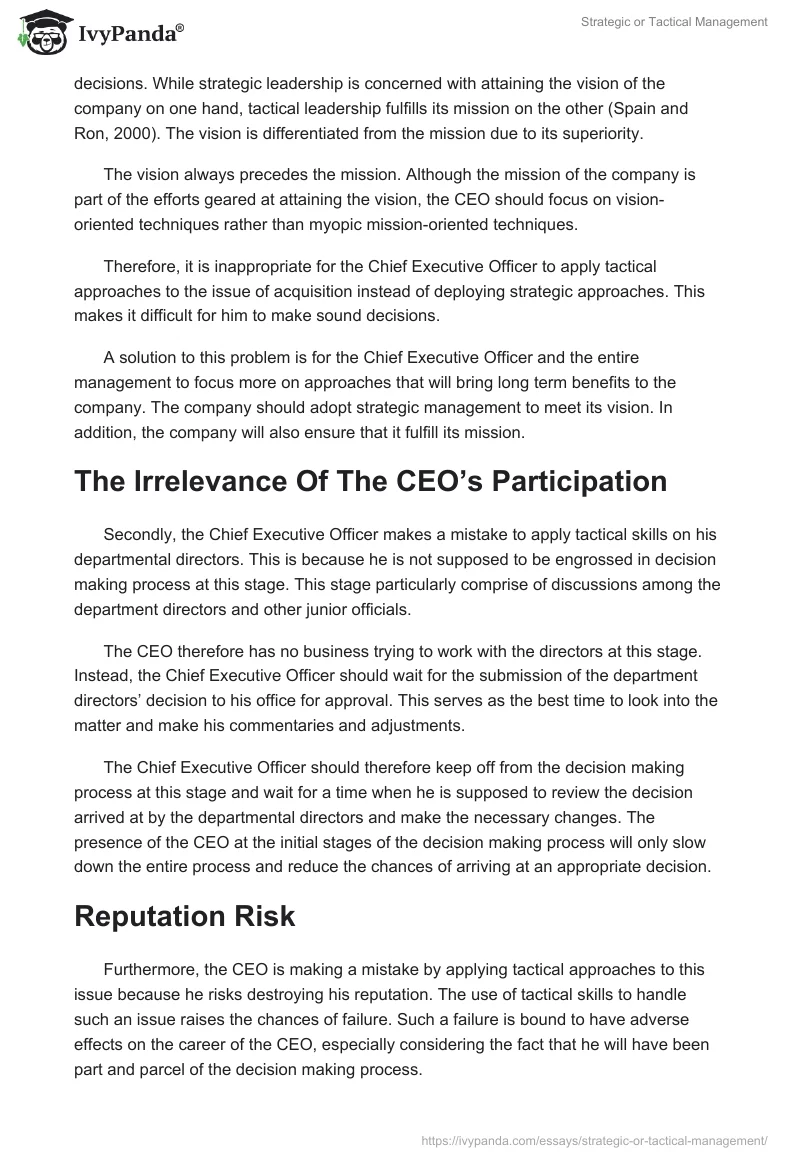Abstract
The leadership of any organization is charged with great responsibility to define the most appropriate course of action to be adopted by the organization. Such decisions are normally made by high ranking officials in the organization such as the Chief Executive Officers and Directors. The success of the organization is contingent on binding decisions made by such leaders.
Due to this reason, the leaders need to be adequately informed every time they make crucial decisions. Lack of sufficient information on pending cases may lead to future managerial problems. Moreover, the leaders should also be in a position to make independent judicious decisions. This is one of the most important abilities that every leader should possess.
Introduction
The Chief Executive Officer is among the high ranking officials in any organization. Such an officer does not have to go to the field to oversee the implementation of projects. Instead, he or she has the privilege to stay in his office and get updated about the status of the organization by his or her junior officers (Scholtes, 1998). However, the case of the CEO discussed in this paper is different.
The CEO has the habit of unconscientiously using tactical leadership methods as opposed to strategic leadership methods which are fit for his position. This paper posits that it is inappropriate for the Chief Executive Officer to apply tactical leadership skills instead of strategic leadership skills. The paper will also discuss appropriate solutions to the problems presented.
Mission And Vision Achievement
The Chief Executive Officer should focus more on using strategic skills instead of tactical skills. This is because strategic skills are appropriate for making the best decisions. While strategic leadership is concerned with attaining the vision of the company on one hand, tactical leadership fulfills its mission on the other (Spain and Ron, 2000). The vision is differentiated from the mission due to its superiority.
The vision always precedes the mission. Although the mission of the company is part of the efforts geared at attaining the vision, the CEO should focus on vision-oriented techniques rather than myopic mission-oriented techniques.
Therefore, it is inappropriate for the Chief Executive Officer to apply tactical approaches to the issue of acquisition instead of deploying strategic approaches. This makes it difficult for him to make sound decisions.
A solution to this problem is for the Chief Executive Officer and the entire management to focus more on approaches that will bring long term benefits to the company. The company should adopt strategic management to meet its vision. In addition, the company will also ensure that it fulfill its mission.
The Irrelevance Of The CEO’s Participation
Secondly, the Chief Executive Officer makes a mistake to apply tactical skills on his departmental directors. This is because he is not supposed to be engrossed in decision making process at this stage. This stage particularly comprise of discussions among the department directors and other junior officials.
The CEO therefore has no business trying to work with the directors at this stage. Instead, the Chief Executive Officer should wait for the submission of the department directors’ decision to his office for approval. This serves as the best time to look into the matter and make his commentaries and adjustments.
The Chief Executive Officer should therefore keep off from the decision making process at this stage and wait for a time when he is supposed to review the decision arrived at by the departmental directors and make the necessary changes. The presence of the CEO at the initial stages of the decision making process will only slow down the entire process and reduce the chances of arriving at an appropriate decision.
Reputation Risk
Furthermore, the CEO is making a mistake by applying tactical approaches to this issue because he risks destroying his reputation. The use of tactical skills to handle such an issue raises the chances of failure. Such a failure is bound to have adverse effects on the career of the CEO, especially considering the fact that he will have been part and parcel of the decision making process.
The fact that a decision made by departmental directors in conjunction with the CEO has failed may not augur well with other senior leaders of the company. In fact, the CEO risks losing his job by indulging in this issue prematurely. Due to this reason, the CEO should steer away from using tactical approaches or even being actively involved in this process at this stage.
The solution for this problem lies with the Chief Executive Officer. The CEO should not risk any involvement in the tactical level decision making process. In fact, the CEO should only receive progress updates from his officers and not insist on personally working together with the directors. By doing so, the Chief Executive Officer will not be disadvantaged in case the decision arrived at by the directors fail.
Possibility Of Making Corrections
In addition, the CEO makes a big mistake by using tactical approaches to deal with the issue of the acquisition at this stage because by doing so, he removes the possibility of a future correction on that particular decision. If the CEO takes part in the decision making process at this stage, a majority of the people will postulate that the decision is already official and cannot be questioned.
His involvement in the process also hinders him from analyzing the decision later in a detailed manner. This may comprise the operations of the company especially in cases where the decision made is not effective in attaining the acquisition.
The removal of the possibility of a correction on the decision made by the Chief Executive Officer and departmental directors is therefore another reason that discourages the participation of the CEO in the decision making process at this level.
In order to avoid jeopardizing the welfare of the company as well as his position, the Chief Executive Officer should avoid getting in the tactical level of decision making as much as possible. This will also allow other officials in the company to analyze the decision made and suggest corrections to the same. The overall effect is to agree on the most viable decision about the acquisition.
Professional Growth Of The Directors
Another reason why the use of tactical approaches to this situation is inappropriate is that it denies the departmental directors the chance to gain experience in the use of strategic techniques. According to Lasher (1999), such directors will have a problem in future when they encounter a problem that can only be solved using strategic techniques.
The CEO should take this opportunity to train the directors about the essence of strategic reasoning and handling problems. Such training will ensure that the company is in safe hands even in the absence of the Chief Executive Officer. The training will also lead to professional development of the directors.
Effects Of The Monotonous Use OF Tactical Approaches
The use of tactical skills to solve this issue and many other issues also makes the CEO to forget the practice of strategic management and decision making. The Chief Executive Officer will equally have a problem when he gets himself in a situation that specifically calls for the use of strategic approaches.
The practice of only applying the tactical skills at this level and many other instances therefore makes the CEO to overlook the necessity of strategic approaches until a time when he is obliged to use them. It is possible that the CEO would have lost the aptitude for strategic management at this time.
In order to avoid the occurrence of such a problem, the Chief Executive Officer should alternate between the use of tactical skills and strategic skills. However, the CEO should dwell more on the use of strategic skills because they are more effective and have long lasting positive effects.
This will ensure that the CEO does not forget the important skills in strategic management (Zack, 1999). It will also give him a chance to continually build on his strategic management skills by exercising them.
Exposure Of The Company To Risks
Moreover, the constant use of tactical skills makes the company to be firmly rooted on them and therefore inflexible. The company will not be in a position to easily shift from tactical to strategic management because of the perpetual use of tactical approaches. This trend may pose a great risk to the company in future if it is obliged to shift abruptly from tactical management to strategic management.
This is attributed to the fact that all the elements of the company would have become accustomed to the tactical paradigm to an extent that deviation from this type of management may lead to the collapse of the entire management process.
The most amicable solution to this problem is the use of strategic management occasioned by tactical management once in a while.
This will make sure that the company does not excessively become accustomed to one type of management and develop the rigidity to swiftly shift to another when it is necessary. The use of both types of management will also make sure that the company gains the benefits that come with using each management type.
Conclusion
It can be inferred from the above discussion that it is risky for the Chief Executive Officer to engage in the decision making process at the tactical level. This may have negative effects on the effectiveness of the decision made, the career of the CEO and the general performance of the company.
It is also advisable that the CEO and the company should avoid sticking to one type of management just in case future circumstances demand drastic change from one type to another. However, it should also be noted that strategic management is the best option to use compared to tactical management.
The main reason for this is that strategic management yields long lasting positive effects. It is therefore advisable for any CEO to apply it in order to ensure effective leadership and managerial success.
Reference List
Lasher, W. (1999). Strategic thinking for small business and divisions. Malden, MA: Blackwell Business.
Scholtes, P. (1998). The leader’s handbook: Making things happen, getting things done. New York: McGraw-Hill.
Spain, C. and Ron W. (2000). Strategic insights: Decision-making tools for business leaders. Grants Pass, OR: Oasis Press.
Zack, H. (1999). Knowledge and strategy. Boston, MA: Butterworth-Heinemann.


